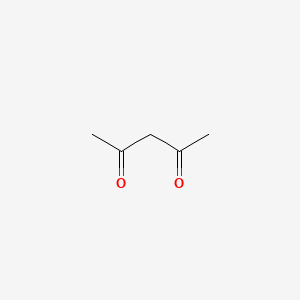| MeSH term | MeSH ID | Detail |
|---|---|---|
| Adenocarcinoma | D000230 | 166 associated lipids |
| Dermatitis, Contact | D003877 | 59 associated lipids |
| Body Weight | D001835 | 333 associated lipids |
| Edema | D004487 | 152 associated lipids |
| Purpura, Thrombocytopenic | D011696 | 2 associated lipids |
| Glioma | D005910 | 112 associated lipids |
| Nervous System Diseases | D009422 | 37 associated lipids |
| Seizures | D012640 | 87 associated lipids |
| Fetal Resorption | D005327 | 15 associated lipids |
| Carcinoma, Lewis Lung | D018827 | 22 associated lipids |
2,4-pentanedione
2,4-pentanedione is a lipid of Fatty Acyls (FA) class. The related lipids are Butyrates.
Cross Reference
Introduction
To understand associated biological information of 2,4-pentanedione, we collected biological information of abnormalities, associated pathways, cellular/molecular locations, biological functions, related genes/proteins, lipids and common seen animal/experimental models with organized paragraphs from literatures.
What diseases are associated with 2,4-pentanedione?
There are no associated biomedical information in the current reference collection.
Possible diseases from mapped MeSH terms on references
We collected disease MeSH terms mapped to the references associated with 2,4-pentanedione
PubChem Associated disorders and diseases
What pathways are associated with 2,4-pentanedione
There are no associated biomedical information in the current reference collection.
PubChem Biomolecular Interactions and Pathways
Link to PubChem Biomolecular Interactions and PathwaysWhat cellular locations are associated with 2,4-pentanedione?
There are no associated biomedical information in the current reference collection.
What functions are associated with 2,4-pentanedione?
There are no associated biomedical information in the current reference collection.
What lipids are associated with 2,4-pentanedione?
Related references are published most in these journals:
| Lipid concept | Cross reference | Weighted score | Related literatures |
|---|
What genes are associated with 2,4-pentanedione?
There are no associated biomedical information in the current reference collection.
What common seen animal models are associated with 2,4-pentanedione?
There are no associated biomedical information in the current reference collection.
NCBI Entrez Crosslinks
All references with 2,4-pentanedione
Download all related citations| Authors | Title | Published | Journal | PubMed Link |
|---|---|---|---|---|
| Guerriero G et al. | Chitin synthases from Saprolegnia are involved in tip growth and represent a potential target for anti-oomycete drugs. | 2010 | PLoS Pathog. | pmid:20865175 |
| Clements AC et al. | Targeting trachoma control through risk mapping: the example of Southern Sudan. | 2010 | PLoS Negl Trop Dis | pmid:20808910 |
| Bult W et al. | Holmium nanoparticles: preparation and in vitro characterization of a new device for radioablation of solid malignancies. | 2010 | Pharm. Res. | pmid:20680667 |
| She H et al. | A nonaqueous approach to the preparation of iron phosphide nanowires. | 2010 | Nanoscale Res Lett | pmid:20672078 |
| Huang SM et al. | Methoxo[N'-(3-meth-oxy-2-oxidobenzyl-idene)benzohydrazidato]oxidovanadium(V). | 2010 | Acta Crystallogr Sect E Struct Rep Online | pmid:21580542 |
| Reddy PB et al. | 1-[5-Acetyl-4-(4-bromo-phen-yl)-2,6-dimethyl-1,4-dihydro-pyridin-3-yl]ethanone monohydrate. | 2010 | Acta Crystallogr Sect E Struct Rep Online | pmid:21580408 |
| Champouret Y et al. | Tris(1,1,1,5,5,5-hexa-fluoro-2,4-pentane-dionato-κO,O')molybdenum(III). | 2010 | Acta Crystallogr Sect E Struct Rep Online | pmid:21580243 |
| Schulz S et al. | (+)-{1,2-Bis[(2R,5R)-2,5-dimethyl-phospho-lan-1-yl]ethane-κP,P'}(η-cyclo-octa-1,5-diene)rhodium(I) tetra-fluorido-borate. | 2010 | Acta Crystallogr Sect E Struct Rep Online | pmid:21579351 |
| Wang S et al. | Hexakis(dimethyl-ammonium) di-μ(6)-oxido-tetra-μ(3)-oxido-tetra-deca-μ(2)-oxido-octa-oxidodeca-vanadate(V) monohydrate. | 2010 | Acta Crystallogr Sect E Struct Rep Online | pmid:21579286 |
| van Dam NM et al. | Identification of biologically relevant compounds in aboveground and belowground induced volatile blends. | 2010 | J. Chem. Ecol. | pmid:20737198 |
